- Details
- Hits: 883
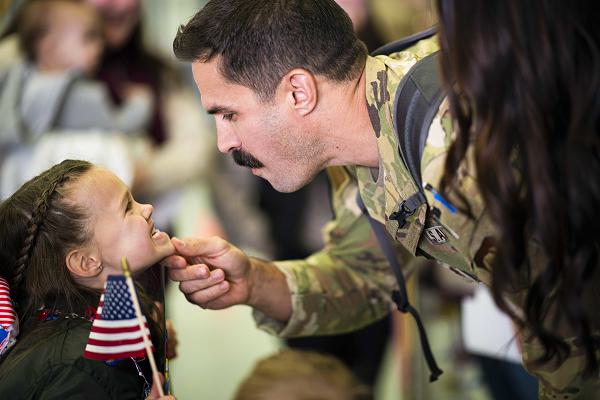
Cheyenne, Wyoming. (April 15, 2024): In this adorable photo by Master Sergeant Jon Alderman, the daughter of Air Force Major Christopher Valine shows off her new smile, minus a few teeth, since they had last seen each other. Major Valine is returning from a three-month deployment to the U.S. Africa Command. Headquartered in Stuttgart, Germany, the Africa Command is responsible for 53 African nations with the exception of Egypt.
Air Force personnel typically deploy for between six to twelve months but they may also do a series of two to three months stints in quick succession. For military families, these rotating deployments can cause havoc with work, school schedules, and vacations.
The Africa Command performs critical missions including neutralizing terrorist groups like al-Shabaab and Boko Haram, interdicting illicit activity in the Gulf of Guinea, and providing humanitarian relief to our African partners.
The Command has military and civilian personnel stationed at Camp Lemonnier, Djibouti; RAF Molesworth, United Kingdom, and at MacDill Air Force Base, Florida. It also maintains offices of security cooperation in thirty-eight African countries.
- Details
- Hits: 2420
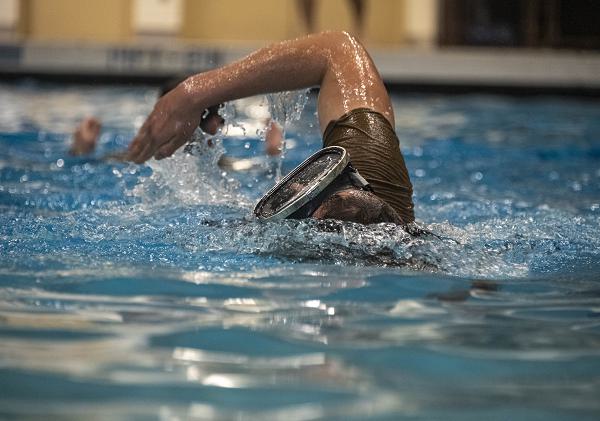
Fairchild Air Force Base, Washington. (April 19, 2024): They are a fearless bunch of parachutists who perform daring rescues of downed pilots and they help prepare others to survive captivity. In this photo by Senior Airman Nicholas Rupiper, an Airman completes a water relay exercise as part of training to become a survival, evasion, resistance, and escape (SERE) specialist. A SERE specialist is an expert on personal survival and enemy resistance who plans and executes personnel recovery missions and trains “high value” targets to avoid or escape from capture. SERE specialists teach individuals how to resist interrogation and exploitation by the enemy.
Today’s SERE training takes lessons learned from the experiences of former POWs to coach potential targets on what is expected of them to “return with honor.” The Air Force 336th Training Group produces SERE instructors as part of its Special Warfare Operations. The instructors teach survival skills, how to evade capture, the military code of conduct, and techniques to escape from captivity. The training is targeted towards people with a high risk of capture such as pilots, aircrew, special operations, intelligence, and foreign diplomatic personnel.
In World War II, the Navy realized that three quarters of its downed pilots had come down alive but only five percent survived. Air crews either could not swim or did not have the survival skills needed. Later in the Korean War, the enemy routinely violated the terms of the Geneva Conventions by torturing and exploiting U.S. prisoners for intelligence or political reasons. Given this new reality, the military put a greater focus on "resistance training". In "resistance" training, SERE instructors function as captors in life-like simulations where soldier/captives are treated as realistically as possible. Trainees are exposed to the hostile treatment they can expect if captured including close confinement, isolation, mock interrogations, and even simulated torture. While it is ethically impossible to reproduce the actual conditions of being an enemy captive, SERE training has proven extremely effective in helping high value targets know what to expect of their captors, and themselves.
To date, SERE Specialists have coordinated over 1300 recovery operations throughout Iraq, Afghanistan, Africa, the Philippines, South and Central America.
- Details
- Hits: 1015

Washington, D.C. (April 5, 2024): It is a little-known agency, but the Biological Defense Research Directorate does everything from defending troops against the threat of biological and chemical attack to tracking genomes in a disease outbreak. Part of the Navy’s Medical Research Command, its mission is to develop strategies for medical defense against biological warfare agents and naturally occurring infectious agents like Covid-19. In this photo by Mike Wilson, Maren Fitzpatrick, a research associate with the Naval Medical Research Command, performs DNA sample quality control in preparation for a sequencing run in its laboratory at Frederick, Maryland. The sequencing data is used to provide surveillance of potential outbreaks and helps identify and characterize a virus’ potential resistance to current treatments.
The Naval Medical Research Command focuses on combat related medical problems such as battlefield neurotrauma, wound infections, biological agents, and naturally occurring infectious diseases. The Biological Defense group emphasizes protecting warfighters in the case of a biological attack while also being prepared to investigate disease outbreaks or threats to public health. Their researchers are considered leaders in their fields including detection, molecular diagnostics, and confirmatory analysis.
As early as the turn of the century, American troops faced the specter of chemical or biological weapons. During World War II, military scientists assembled at what is now Camp Detrick in 1943 to develop ways to protect our troops from enemy gas attacks. From this came a research program involving pioneering laboratory methods that were soon turned to the benefit of the public to spot infectious diseases.
Today, the laboratory is a national source for testing and analysis of biological hazards and the disciplines of Genomics, Immunodiagnostics, and Molecular research.
- Details
- Hits: 950
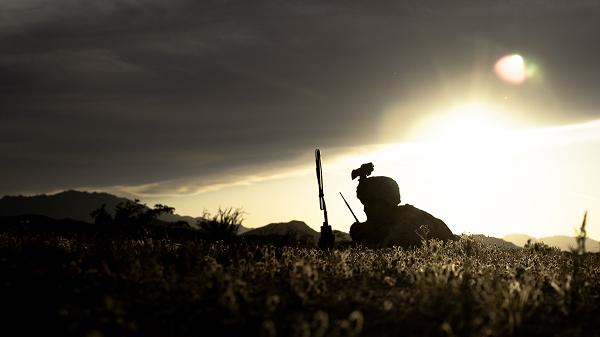
Hawk Eye, Arizona. (April 3, 2024): In this desert wilderness, America’s finest aviators are teaching future instructors in a grueling seven-week course in advanced weapons and tactics. In this photo by Corporal Tyler Raab, Marine Lance Corporal Elijah Scott, an air traffic control navigational aids technician assigned to Marine Aviation Weapons and Tactics Squadron One, monitors the radio during an expeditionary air traffic control exercise. Officially dubbed the Weapons and Tactics Instructors course (WTI), this graduate-level program gives advanced tactical training to future instructors who then bring their knowledge and experience back to their unit. Students graduate as experts on their particular aircraft and how to plan and train others.
To attend this advanced course, pilots must possess a number of certifications including previous experience as a low altitude and air combat instructor. Candidates will spend nearly two months doing class work, practicing on flight simulators, and pilot training on their specific aircraft. Their instructors are hand-picked from the very finest in American military aviation.
The Marines see the value in having their most experienced flyers “Train the Trainers” for the next generation of military aviators.
- Details
- Hits: 1692
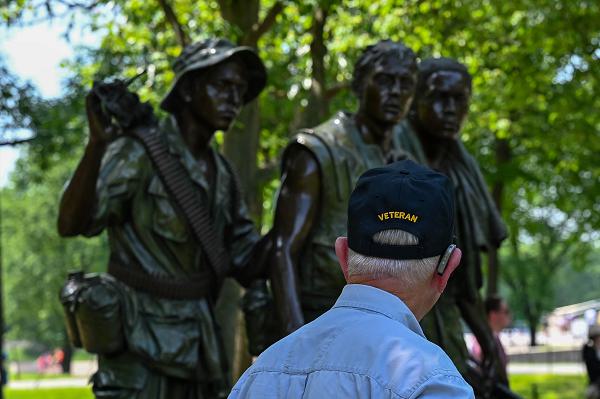
Washington, D.C. (April 10, 2024): A monument to honor America’s Vietnam veterans was steeped in controversy at first but a compromise emerged that gave us the stunning Three Serviceman Statue that keeps watch on The Wall to this day. In this photo by Staff Sergeant Sarah Sangster, a veteran visits the Vietnam Veterans Memorial and Three Serviceman monument honoring those who died or are missing from that tumultuous conflict.
Critics initially panned the wall’s design, created by American architect Maya Lin, as "a black gash of shame" or a "giant tombstone." For many, the design was too abstract for those expecting a more heroic, life-like depiction of soldiers in combat such as the Marines raising the flag on Iwo Jima. Supporters countered that the art is a prime example of minimalist architecture that deliberately lacks heroic ornamentation.
A compromise was reached when Sculptor Frederick Hart was commissioned to create the Three Serviceman’s statue as a permanent addition to the original Wall. Added to the memorial in 1984, the statue depicts three American servicemen and the things they carried as a testament to the experiences of Vietnam veterans.
- Details
- Hits: 1092
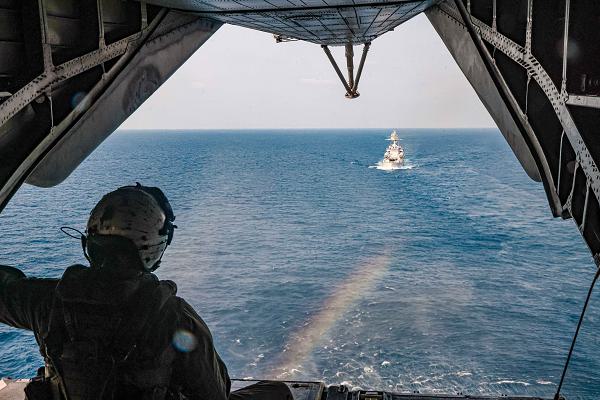
Indian Ocean. (March 31, 2024): In another sign of growing collaboration between the U.S. and India, American Marines are participating in Exercise Tiger Triumph with the Indian Navy. In this photo by Corporal Aidan Hekker, Corporal Jacob Sellers watches as a giant CH-53E Super Stallion helicopter takes off into the Indian Ocean in this U.S./India amphibious exercise focused on humanitarian assistance and disaster relief.
This is the third iteration of Tiger TRIUMPH, short for Tri-Services India-U.S. Amphibious Exercise, held in the waters near Visakhapatnam and Kakinada, India. Ironically, there was little cooperation or defense sales to India just twenty years ago. Today, by conducting joint maneuvers like these, both countries have now built intelligence sharing channels to better identify and defeat potential threats. In addition to rising arms sales, India has agreed to allow U.S. military access and Indian units are now conducting regular military exercises with the U.S. to improve joint capabilities and interoperability between forces.
As part of the exchange, India receives access to critical technologies including artificial intelligence, advanced sensor development, and the latest unmanned systems. Future collaboration will include the joint production of General Electric F-414 jet engines in India to power its Indigenous fighter aircraft.
These efforts are part of the Quadrilateral Security Dialogue, commonly called the Quad, which is a strategic security dialogue among Australia, India, Japan, and the United States. The goal is to counter Chinese aggression through a policy of “integrated deterrence” where India’s is better able to defend itself and deter aggression.
Most importantly, the military cooperation between the U.S. and India is growing and keeping our adversaries guessing.


